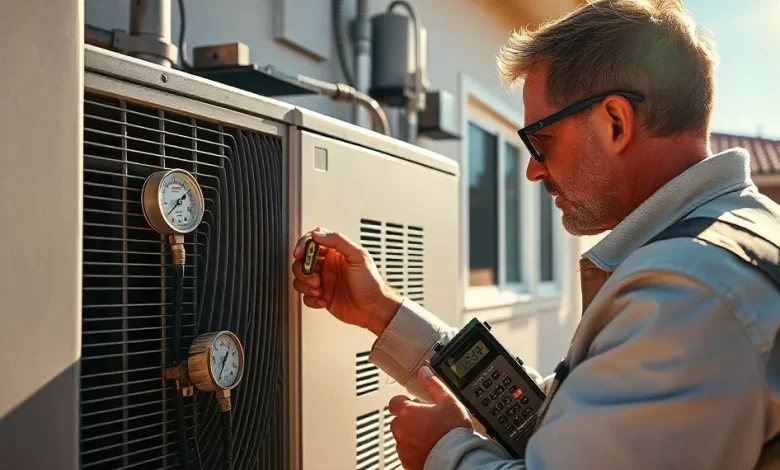Can You Fix a Freon Leak?

Did you know that a single freon leak can significantly reduce your air conditioner’s cooling efficiency and contribute to environmental harm? If your air conditioner is no longer keeping you cool on hot days, it might be time to address the problem. But can you really fix a freon leak? Let’s explore the signs, dangers, and solutions while unraveling the mysteries of refrigerant leaks.

What is Freon, and Why is it Important?
Freon, a brand name for specific refrigerants, plays a critical role in cooling systems by absorbing heat from indoor air and releasing it outdoors. However, refrigerants like Freon are hazardous when they leak, impacting both the environment and your health. Understanding what Freon does and its significance is the first step toward recognizing and addressing potential leaks.
Signs of a Freon Leak
Spotting a freon leak early can save you from increased utility bills and prevent damage to your air conditioner. Here are some common signs:
Reduced Cooling Performance
When your AC struggles to cool your space effectively, it could signal a loss of refrigerant. Without adequate Freon, the system cannot maintain the desired temperature.
Higher Energy Bills
Freon leaks force your AC to work harder, consuming more energy. This not only impacts your wallet but also strains the unit, shortening its lifespan. For tips on managing energy costs, check out this guide on increased utility bills.
Unusual Noises
Hissing or bubbling sounds near the refrigerant lines may indicate a leak. These noises often occur when Freon escapes under pressure.
Ice Buildup
A leaking AC may develop ice on the evaporator coil due to insufficient refrigerant levels, disrupting heat exchange.
Pungent Odors
Freon leaks can emit a sharp, unpleasant smell. If you notice a strange odor near your unit, it’s time to investigate.
Why Freon Leaks are Dangerous
A freon leak is not just a nuisance; it poses serious risks to health and the environment. Here’s what you need to know:
Impact on Health
Freon exposure can cause respiratory problems, skin irritation, and even symptoms such as nausea and dizziness. If inhaled, it can lead to severe complications. Learn more about these effects, including such as nausea.
Environmental Hazards
Freon contributes to ozone depletion, which can accelerate climate change. This environmental concern has prompted stricter regulations on Freon usage and disposal.
How to Detect a Freon Leak
Identifying a freon leak involves a combination of observation and specialized tools. Here are some methods:
Visual Inspection
Look for oil stains, ice buildup, or corrosion around the refrigerant lines. These signs often point to leaks.
Electronic Leak Detectors
These devices sense refrigerant in the air and are highly effective in pinpointing leaks.
UV Dye Tests
Injecting UV dye into the AC system allows for easy detection using a UV light. This method is particularly helpful in finding smaller leaks.
Pressure Gauge Testing
By comparing the system’s pressure readings with manufacturer specifications, technicians can confirm the presence of a leak.
Common Causes of Freon Leaks
Understanding why leaks occur can help you prevent them. Here are some common causes:
Age and Wear
Over time, components like refrigerant lines degrade, making older systems more prone to leaks.
Poor Installation
Improperly sealed connections during installation can result in leaks. Relying on expert electrical installation services ensures a secure setup.
Physical Damage
Accidental punctures or impacts can damage refrigerant lines, leading to leaks. Handle your AC unit carefully to avoid such issues.
Corrosion
Moisture or chemical exposure can corrode refrigerant lines. Regular maintenance helps catch and address early signs of corrosion.
Can You Fix a Freon Leak?
Fixing a freon leak is not a DIY project. It requires professional expertise and specialized equipment. Here’s how technicians typically address leaks:
Step 1: Identify the Leak
Professionals use detection tools and methods to locate the exact source of the leak.
Step 2: Repair or Replace Components
Depending on the severity of the damage, technicians may repair the refrigerant line or replace affected parts.
Step 3: Seal the Leak
Small leaks can be sealed using specialized epoxy or sealants. This step ensures no further refrigerant escapes.
Step 4: Recharge the System
Once repaired, the system is recharged with the appropriate amount of refrigerant to restore optimal performance.
The Role of Preventive Maintenance
Preventive maintenance is the key to avoiding freon leaks. Regular inspections and tune-ups can detect early signs of wear and tear, reducing the likelihood of leaks. Check out these areas of your home that require regular maintenance to keep your entire household running smoothly.
Conclusion: Don’t Delay—Fix Freon Leaks ASAP
Freon leaks are more than just an inconvenience; they’re a threat to your comfort, health, and the environment. By recognizing the signs and understanding the dangers, you can take prompt action to address the issue. Always rely on qualified HVAC professionals for repairs, and prioritize regular maintenance to keep your cooling system in top shape. Staying informed and proactive ensures your home stays cool and eco-friendly year-round.



